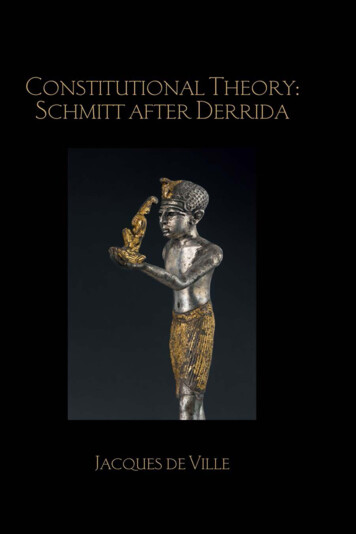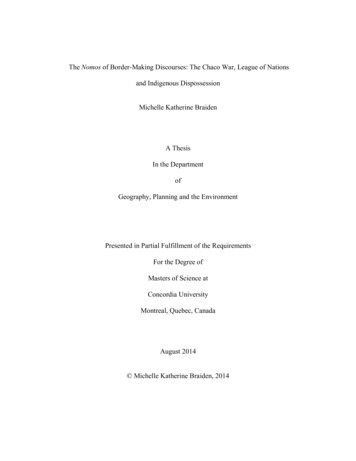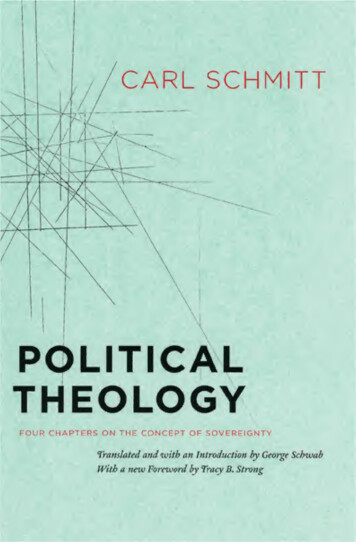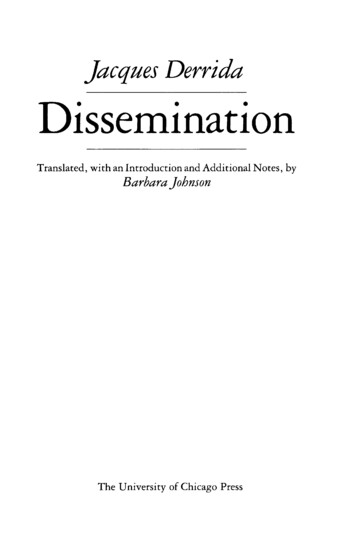
Transcription
Constitutional Theory:Schmitt after DerridaThis book advances a new reading of the central works of Carl Schmitt and, inso doing, rethinks the primary concepts of constitutional theory. In this book,Jacques de Ville engages in a close analysis of a number of Schmitt’s texts,including Dictatorship (1921), The Concept of the Political (1927), ConstitutionalTheory (1928), Land and Sea (1942), Ex Captivitate Salus (1950), The Nomosof the Earth (1950) and The Theory of the Partisan (1963). This engagementtakes place from the perspective of constitutional theory and focuses specificallyon concepts or themes such as sovereignty, the state, the political, constituentpower, democracy, representation, the constitution and human rights. The bookseeks to rethink the structure of these concepts in line with Derrida’s analysisof Schmitt’s texts on the concept of the political in Politics of Friendship (1993).This happens by way of an analysis of Derrida’s engagement with Freud andother psychoanalysts. Although the main focus in the book is on Schmitt’s texts,it further examines two texts of Derrida (Khōra (1993) and Fors: The AnglishWords of Nicholas Abraham and Maria Torok (1976)), by reading these alongsideSchmitt’s own reflections on the positive concept of the constitution.Jacques de Ville is Professor of Law at the University of the Western Cape,South Africa.
Constitutional Theory:Schmitt after DerridaJacques de Ville
First published 2017by Birkbeck Law Press2 Park Square, Milton Park, Abingdon, Oxon OX14 4RNand by Birkbeck Law Press711 Third Avenue, New York, NY 10017Birkbeck Law Press is an imprint of the Taylor & Francis Group, an informa business 2017 Jacques de VilleThe right of Jacques de Ville to be identifed as author of this work has beenasserted by him in accordance with sections 77 and 78 of the Copyright,Designs and Patents Act 1988.The Open Access version of this book, available at www.taylorfrancis.com,has been made available under a Creative Commons Attribution-NonCommercial-No Derivatives 4.0 license.Trademark notice: Product or corporate names may be trademarks orregistered trademarks, and are used only for identification and explanationwithout intent to infringe.British Library Cataloguing in Publication DataA catalogue record for this book is available from the British LibraryLibrary of Congress Cataloging in Publication DataNames: De Ville, Jacques, author.Title: Constitutional theory : Schmitt after Derrida / Jacques de Ville.Description: Abingdon, Oxon [UK]; New York : Routledge, 2017. Includes bibliographical references and index.Identifiers: LCCN 2016044265 ISBN 9781138293786 (hardback) ISBN 9781351866408 (adobe reader) ISBN 9781351866392 (epub3) ISBN9781351866385 (mobipocket)Subjects: LCSH: State, The. Constitutional law—Philosophy. Constituentpower. Constitution (Philosophy) Human rights. Derrida, Jacques.Politiques de l’amitié. English. Schmitt, Carl, 1888–1985.Classification: LCC K3165. D425 2017 DDC 342.001—dc23LC record available at https://lccn.loc.gov/2016044265ISBN: 978-1-138-29378-6 (hbk)ISBN: 978-0-367-02414-7 (pbk)ISBN: 978-1-315-23188-4 (ebk)Typeset in Times New Romanby Keystroke, Neville Lodge, Tettenhall, Wolverhampton
For Zanél, Chloé and Kelsey
ContentsAcknowledgementsNote on translations and referencesList of abbreviationsxixiiixv1IntroductionSchmitt and Derrida 1Constitutional theory 1Reading Schmitt 2Sequence and overview of chapters 612The concept of the politicalA. Polémios 11Introduction 11Plato 13Schmitt 15Freud 22Heidegger 25The structure of the political 31B. Partisan 32Introduction 32Criteria 34The question of technology 36Philosophy and the Acheron 38The brother as double 43Woman as the absolute partisan 49Today’s terror and the structure of the political 50C. Self 53Introduction 53Defining man: nakedness 549
viiiContentsStirner and his ego 55Modern technology 58Being-placed-in-question 60Self-deception 62Descartes and the self as enemy 65Hegel and the enemy 67Echo 70The concept of the political 723Constituent powerIntroduction 74Political unity 75Political theology 78Fear and the Leviathan 82Demos without sovereignty 85Conclusion 89744Identity and representationIntroduction 90The formation of identity 91Representation reconceived 95Conclusion 101905The concept of the constitutionA. Khōra 104Introduction 104Derrida’s reading of the Timaeus 105Khōra and the political 111Constitutions as giving place 116B. Crypt 121Introduction 121The Wolf Man 123The Wolf Man’s crypt 128Constitution, memory and trauma 1371026Human rightsIntroduction 139Freedom 140Equality 154Living together 160139
Contentsix7State, Groβraum, nomosIntroduction 163Nomos 164Man, space, nomos 177Conclusion 1791638ConclusionSchmitt ‘before’ Derrida 182Derrida reading Schmitt 183Schmitt ‘after’ Derrida 185182BibliographyIndex187205
AcknowledgementsA few people deserve special mention here for their sharing of insights andproviding support and assistance to me over the years leading to the presentpublication. These include Jaco Barnard-Naudé, Henk Botha, Cosmin Cercel,Julia Chryssostalis, Wessel le Roux, Susanna Lindroos-Hovinheimo, PanuMinkkinen, Stewart Motha, Kessler Perumalsamy, Nico Steytler and Philippe vanHaute.Lynn Thomas and Hazel Jeftha are thanked for providing administrativesupport, as well as the personnel at the University of the Western Cape library,specifically Messrs Fortune and Tarkey and Mmes Moon, Mpandle and Primo.Costas Douzinas, Fiona Macmillan and the rest of the editorial board ofBirkbeck Law Press, as well as Colin Perrin, are thanked for their support of thisproject.I would also like to express my thanks to the two anonymous reviewers fortheir comments.Earlier versions of most of the chapters included in the present publicationhave been presented at conferences and some have appeared in print before. Eachof these papers, articles and chapters were thoroughly reworked for the presentpublication: Chapter 2, Section A was presented at the International Symposiumfor Phenomenology, 8–13 July 2013, held in Perugia, Italy, and was publishedin 2015 as ‘The foreign body within the body politic: Derrida, Schmitt and theconcept of the political’, Law and Critique, 26(1): 45–63. Chapter 2, Section Bwas presented at a Swedish-Finnish workshop ‘Friend or Foe? The ContemporaryRelevance of Carl Schmitt’, 17–18 June 2013 at the Faculty of Law, University ofHelsinki, Finland and was published in 2016 as ‘Rethinking the concept of thepolitical: Derrida’s reading of Schmitt’s “The Theory of the Partisan”’, pp. 134–46, in M. Arvidsson, L. Brännström and P. Minkkinen (eds), The ContemporaryRelevance of Carl Schmitt: Law, Politics, Theology, Abingdon and New York:Routledge. Chapter 2, Section C was presented at the Critical Legal Conference,5–7 September 2013, held at the Queen’s University Belfast, Northern Ireland andwas published in 2016 as ‘Schmitt’s Weisheit der Zelle: rethinking the concept ofthe political’, pp. 215–31, in S. Motha and H. van Rijswijk (eds), Law, Violence,Memory: Uncovering the Counter-Archive, Abingdon and New York: Routledge.
xii AcknowledgementsChapter 3 was presented at the Derrida Today Conference, 8–11 June 2016, heldat Goldsmiths, University of London. Chapter 4 was presented at the CriticalLegal Conference, 1–3 September 2016, held at the University of Kent, UK.Chapter 5(a) was presented at the International Summer School on Religion,Law and Justice, 24–26 February 2015, University of the Western Cape, SouthAfrica, and at the conference Law in Crisis: New Developments, 25 September2015, Potchefstroom, North-West University, South Africa. Chapter 5, Section Bwas presented at the International Symposium for Phenomenology, 6–11 July2015, held in Perugia, Italy. Chapter 7 was presented at the Critical LegalConference, 3–5 September 2015, held at the University of Wrocław, Poland.Chapter 2, Section C, Chapter 5, Section A and Chapter 6 were (also) presented atFaculty and Departmental Seminars of the University of the Western Cape. Iwould like to express my thanks to all the participants in these seminars, workshops,conferences and symposia for their useful comments, as well as to the publishersfor permission to include the material previously published, in the presentpublication.
Note on translations andreferencesIn the chapters that follow, reference will as a rule be made only to the Englishversion where a translation of a specific text of Schmitt and Derrida is available.If a quotation is at stake or where the wording of the original French (in the caseof Derrida) or German (in the case of Schmitt) is a central issue, reference will bemade to both the translation and the original, where the latter was available to me.The same applies to the translated texts of other authors. Reference to the originaltext is essential for purposes of the close reading of Schmitt, and to some extentof Derrida, undertaken here.Where no reference is made to a specific English translation of a text in theoriginal French and German by Derrida, Schmitt or another author, the translationis my own.English translations have in many cases been modified. This will not bespecifically indicated in respect of each translation so modified.
List of abbreviationsFor ease of reference, the following abbreviations are used for the most frequentlycited texts of Derrida and of Schmitt. Full references are given in the Bibliography.AdieuAR‘Auto’BdPB&S IB&S IICoPCPCPDCTCWDDARDDCDDDisDissDJDLDPSDTAdieu: to Emmanuel Levinas (Derrida 1999b)Acts of Religion (Derrida 2002a)‘Autoimmunity: real and symbolic suicides – a dialogue withJacques Derrida’, in Philosophy in a Time of Terror: Dialogues withJürgen Habermas and Jacques Derrida (Derrida 2003a)Der Begriff des Politischen (Schmitt 2002a)The Beast & the Sovereign, vol. I (Derrida 2009)The Beast & the Sovereign, vol. II (Derrida 2011a)The Concept of the Political (Schmitt 2007a)La Carte Postale: de Socrate à Freud et au-delà (Derrida 1980)The Crisis of Parliamentary Democracy (Schmitt 1988a)Constitutional Theory (Schmitt 2008a)Chora L Works (Derrida and Eisenman 1997)Dictatorship: From the Origin of the Modern Concept of Sovereigntyto Proletarian Class Struggle (Schmitt 2014a)Über die drei Arten des rechtswissenschaftlichen Denkens (Schmitt2006c)Donoso Cortés in gesamteuropäischer Interpretation (Schmitt2009a)Die Diktatur: Von den Anfängen des modernen Souveranitätsgedankensbis zum proletarischen Klassenkampf (Schmitt 2006b)Dissemination (Derrida 2004a)La Dissémination (Derrida 1972b)‘Eröffnung’ and ‘Schluβwort’ in Das Judentum in derRechtswissenschaft (Schmitt 1936a and b)Der Leviathan in der Staatslehre des Thomas Hobbes: Sinn undFehlschlag eines politischen Symbols (Schmitt 2012a)Dialogues on Power and Space (Schmitt 2015)Donner le Temps (Derrida 1991)
xviList of abbreviationsECSÉ&DEOETFAFdL‘F&K’Ex Captivitate Salus: Erfahrungen der Zeit 1945/47 (Schmitt 2010c)L’Écriture et la Différence (Derrida 1967)The Ear of the Other (Derrida 1988c)Echographies of Television (Derrida and Stiegler 2002)Four Articles: 1931–1938 (Schmitt 1999)Force de Loi (Derrida 2005c)‘Faith and knowledge: the two sources of “religion” at the limits ofreason alone’ in Religion (Derrida 1998a)‘Fore’‘Foreword: Fors: the anglish words of Nicolas Abraham and MariaTorok’, in The Wolf Man’s Magic Word: A Cryptonomy (Derrida1986b)Fors‘Fors: Les mots anglés de Nicolas Abraham et Maria Torok’ inCryptymie le Verbier de l’Homme aux Loups (Derrida 1976b)FPFrieden oder Pazifismus? Arbeiten zum Volkerrecht und zurinternationalen Politik 1924–1978 (Schmitt 2005a)F&SFoi et Savoir: Suivi de le Siècle et le Pardon (Derrida 2001b)FWTFor What Tomorrow . . . A Dialogue (Derrida and Roudinesco2004)‘Geschl IV’ ‘Heidegger’s ear: philopolemology (Geschlecht IV)’, in ReadingHeidegger (Derrida 1993a)GLGlossarium: Aufzeichnungen der Jahre 1947–1951 (Schmitt 1991)G<he Gift of Death & Literature in Secret (Derrida 2008a)GlasGlas (Derrida 1986a)Glas (F)Glas (Derrida 1974)GLPDie geistesgeschichtliche Lage des heutigen Parlamentarismus(Schmitt 2010d)‘GP’‘Gespräch über den Partisanen’, in Guerrilleros, Partisanen: Theorieund Praxis (Schmitt and Schickel 1970)GTGiven Time: I. Counterfeit Money (Derrida 1992a)HdVDer Hüter der Verfassung (Schmitt 1996a)KhôraKhôra (Derrida 1993d)LLLegality and Legitimacy (Schmitt 2004c)L&LLegalität und Legitimität (Schmitt 2012b)L&MLand und Meer: Eine weltgeschichtliche Betrachtung (Schmitt2008e)L&SLand and Sea (Schmitt 1997)LtdLimited Inc (Derrida 1988a)NdEDer Nomos der Erde im Völkerrecht recht des Jus PublicumEuropaeum (Schmitt 2011a)NegNegotiations: Interventions and Interviews 1971–2001 (Derrida2002b)NoEThe Nomos of the Earth in the International Law of the Jus PublicumEuropaeum (Schmitt 2006a)OHOf Hospitality (Derrida and Dufourmantelle 2000)
List of abbreviationsONPAPBPCPdSPoFPointsPsy IPsy IIPsy II (F)PTPT (G)PT IIPT II (G)RCResRKRogSB&S ISB&S IISBVSdMSGNSMPSoMSPSQTdPTLTOHxviiOn the Name (Derrida 1995c)Politiques de l’amitié (Derrida 1994)Positionen und Begriffe im Kampf mit Weimar – Genf – Versailles1923–1939 (Schmitt 1994)The Post Card: From Socrates to Freud and Beyond (Derrida 1987)Points de Suspension: Entretiens (Derrida 1992c)Politics of Friendship (Derrida 1997a)Points . . . Interviews, 1974–1994 (Derrida 1995a)Psyche: Inventions of the Other, vol. I (Derrida 2007a)Psyche: Inventions of the Other, vol. II (Derrida 2008b)Psyché: Inventions de l’Autre, vol. II (Derrida 2003c)Political Theology: Four Chapters on the Concept of Sovereignty(Schmitt 2005b)Politische Theologie: Vier Kapitel zur Lehre von der Souveränität(Schmitt 2004d)Political Theology II: The Myth of the Closure of any PoliticalTheology (Schmitt 2008c)Politische Theologie II: Die Legende von der Erledigung jederPolitischen Theologie (Schmitt 2008b)Roman Catholicism and Political Form (Schmitt 1996b)Resistances of Psychoanalysis (Derrida 1998b)Romischer Katholizismus und politische Form (Schmitt 2008f)Rogues: Two Essays on Reason (Derrida 2005b)Séminaire: La Bête et le Souverain, vol. I (Derrida 2008d)Séminaire: La Bête et le Souverain, vol. II (Derrida 2010)Staat, Bewegung, Volk: Die Dreigliederung der politischen Einheit(Schmitt 1934)Spectres de Marx: l’État de la Dette, le Travail du Deuil et laNouvelle Internationale (Derrida 1993c)Staat, Groβraum, Nomos: Arbeiten aus den Jahren 1916–1969(Schmitt 1995)State, Movement, People: The Triadic Structure of the PoliticalUnity (Schmitt 2001)Specters of Marx: The State of Debt, the Work of Mourning, and theNew International (Derrida 2006a)Speech and Phenomena and Other Essays on Husserl’s Theory ofSigns (Derrida 1973)Sovereignties in Question: The Poetics of Paul Celan (Derrida(2005a)Theorie des Partisanen: Zwischenbemerkungen zum Begriff desPolitischen (Schmitt 2010a)The Leviathan in the State Theory of Thomas Hobbes: Meaning andFailure of a Political Symbol (Schmitt 2008d)The Other Heading: Reflections on Today’s Europe (Derrida 1992b)
xviii‘TP’TTJTVLVoyVRAWDWMWoWList of abbreviations‘The Theory of the Partisan: a commentary/remark on the conceptof the political’ (Schmitt 2004a)On the Three Types of Juristic Thought (Schmitt 2004b)Verfassungslehre (Schmitt 2010b)Voyous: Deux Essais sur la Raison (Derrida 2003b)Verfassungsrechtliche Aufsätze aus den Jahren 1924–1954:Materialien zu einer Verfassungslehre (Schmitt 2003)Writing and Difference (Derrida 1978)The Work of Mourning (Derrida 2001a)Writings on War (Schmitt 2011c)
Chapter 1IntroductionSchmitt and DerridaDespite their very pronounced political and theoretical differences, JacquesDerrida (1930–2004) devotes three chapters to the texts of Carl Schmitt (1888–1985) in his Politics of Friendship (1994), in seeking a beyond to the traditionalconception of friendship in the metaphysical tradition. Here Derrida, differentfrom other contemporary philosophers,1 affirms in large part Schmitt’s analysis ofthe enemy by exploring in detail The Concept of the Political (1927), ‘The Theoryof the Partisan’ (1963) and ‘Weisheit der Zelle’ (1947).2 Derrida’s analysis ofSchmitt’s texts has thus far found little resonance with scholars within constitutional theory and other, related fields. The political-theological reading of Schmittby Meier (1998), as well as the reading of Schmitt by Agamben (1998; 2005) withits emphasis on sovereignty and the exception, has thus far been much more influential. There is no doubt considerable value in the readings of Meier and Agambenas well as in the readings of their followers, which will be relied on in the analysisthat follows, yet the present publication (hereafter ‘SAD’) returns to Derrida’sreading of Schmitt and gives it a certain preferential status. It specifically raisesthe question as to the implications for constitutional theory should one take seriously Derrida’s deconstruction of Schmitt’s concept of the political in Politics ofFriendship. Can such a reading provide a foundation for constitutional discourse?The answer, which will be given in Chapter 8, will be an ambivalent yes and no.Constitutional theoryWhy ‘constitutional theory’? The latter is of course the title of the 2008 translationof Schmitt’s highly acclaimed Verfassungslehre (1928). In this text, Schmitt spells1 See e.g. Agamben (1998: 8): ‘The fundamental categorical pair of Western politics is not that offriend/enemy but that of bare life/political existence, zoē/bios, exclusion/inclusion’.2 Derrida also refers to Schmitt in a number of other texts, including Rogues, ‘Autoimmunity’ and TheBeast & the Sovereign, vols I and II.
2Constitutional Theoryout the radical implications of his own analysis in The Concept of the Political,thereby dislocating the foundations of liberal constitutionalism. He argues in thisrespect that the political component of modern constitutions, which is repressedby liberal thinking through its privileging of the rule of law, separation of powersand freedom, is in fact the most important component of a constitution. In showingthe priority of the political component, Schmitt insists on drawing a distinctionbetween the constitution as such and constitutional laws; distinguishes between,yet shows the interdependence between, the two principles of political form, thatis, identity and representation; resurrects the concept of sovereignty in the form ofconstituent power; understands equality as first of all and necessarily implying aninequality in respect of those who are excluded from the political unity; andsubjects freedom to the political component of the constitution.The focus in SAD will be on some of the main concepts and themes explored bySchmitt in Constitutional Theory, which intersect with the thinking of Derrida.These include: sovereignty; the state; the political; constituent power; democracy;representation; the constitution; human rights, specifically freedom and equality;as well as the international and transnational framework within which nationalconstitutions operate.3 SAD will closely analyse Schmitt’s Constitutional Theoryas well as a number of Schmitt’s other texts, and will more specifically seek toreconceptualise the above-mentioned concepts in line with Derrida’s thinking,whilst remaining faithful to Schmitt’s texts. The forces at the origin of the modernconstitution will be central to this analysis. This was also Schmitt’s concern, andremains the concern today of constitutional theorists. A reading of Schmitt througha Derridean lens allows us to rethink such origin and, as we will see in whatfollows, makes it possible to view a constitution as a gift without return to the self.Reading SchmittThe first possible reading strategy in respect of Schmitt, that is, apart from agreeingwith his analyses in all or most respects, would be to critically engage in refutation,and to seek rational and logical alternatives to the conservative and often authoritarian responses he gives to the burning questions of constitutional theory. Thisstrategy will not be adopted here, at least not as a primary strategy, becauserefutation, as Derrida (2016: 2) points out, still belongs to metaphysics, and takesno step beyond it. A second possible strategy would be to simply ignore ordisregard Schmitt because of his Nazi collaboration and anti-Semitism. Writingabout him would, in the view of some, even make one complicit in these stances.In support of this reading strategy, and as set out in more detail in later chapters,there can be little doubt that Schmitt’s anti-Semitism was pervasive, that is, not3 Although Derrida explores all of these ‘themes’ in his texts, he does not necessarily do so withreference to Schmitt.
Introduction 3adopted by him simply in order to curry favour with the Nazis from 1933 to 1936.Are all his texts thereby tainted with anti-Semitism,4 or is it possible, as a thirdpossible reading strategy, to distinguish and separate Schmitt’s politicalcommitments from his thinking? A reductive reading of Schmitt as an anti-Semitefails to take account of the Freudian insight into the inevitable tensions andcontradictions in a person’s life and thinking. The consequential idea that Schmittshould because of his anti-Semitism be isolated and ignored, or that this can bedone in respect of a certain part of his work, likewise fails to take accountof Freud’s insights regarding human nature.5 As Malpas points out in respect ofHeidegger’s recently published Black Notebooks, 1931–1941:[t]here is surely nothing of which humans are capable that is not also apossibility to which we are ourselves connected just by virtue of our beinghuman . . . . This is partly why the Holocaust is so horrific – it is a horror thatproceeds, not from something that is other than human, nor from some singleperson (Hitler) or exclusive group of persons (the Nazis, the Germans, theEuropeans) such that they could be set apart, excluded or quarantined fromthe rest of us, but from a possibility that belongs to human being itself.(Malpas 2016: 10–11)The above passage is cited here because of the centrality of human nature and ofpsychoanalysis for the reading strategy or analysis that follows. This ‘analysis’will not involve a psychoanalysis of Schmitt himself, though his texts will indeedbe subjected to what can be called here a ‘quasi-psychoanalysis’, the nature ofwhich will be clarified in what follows. Malpas in the above passage and in therest of his chapter on Heidegger makes out a strong argument that there is indeedan obligation to seek to understand thinkers like Heidegger and Schmitt, specifically the relation between their anti-Semitism and their philosophical thinking.This is an obligation which Derrida took very seriously, especially in the case ofHeidegger.6 In the case of Schmitt, this obligation should arguably also involve anattempt to understand the seemingly important role of a certain political theologyin his thinking,7 though without ignoring the tensions and contradictions in histexts.Derrida’s reading of Schmitt in Politics of Friendship does not consist of asimple affirmation of Schmitt’s contentions, a critique or an attempt to separate the‘good’ from the ‘bad’. This follows from what could in some sense be calledDerrida’s general ‘project’, that is, the deconstruction of the metaphysics of4567See e.g. Gross (2015).See e.g. Freud (2001, XIV: 281) on the impossibility of eradicating ‘evil’.See e.g. Derrida (1988b).See in this respect, Meier (1998).
4Constitutional Theorypresence.8 In brief, Derrida seeks to show that metaphysics has a (problematic)desire for presence as its founding principle, and he seeks a passage beyond this.This general project is ‘executed’ in a singular manner in respect of each textwhich Derrida reads, so that no ‘method’, which is applied in the same manner toall texts, can be said to be at stake here. Another text, another event in a senseannounces itself through each reading, which cannot simply be traced back tothe author and his work (Derrida 1988b: 91). In Limited Inc, where Derridaengages with the thinking of J. L. Austin and John Searle in their analyses ofspeech act theory, Derrida is very explicit about the ‘strategy’ that he follows,specifically in exposing the structural impossibility as well as illegitimate logic atstake in metaphysical thinking. It also gives us a foretaste of how Derrida willengage with Schmitt’s texts in Politics of Friendship, and thus assists us inunderstanding Schmitt’s own strategy as a metaphysical thinker in the constructionof concepts. Schmitt was no doubt acutely aware of what was at stake in suchconstruction, as appears for example from the essay ‘Reich – Staat – Bund’:In the political battle, concepts and conceptualised words are anything butempty sound. They are the expression of sharp and precisely elaboratedoppositions and friend-enemy constellations. Understood thus, the content ofworld history which is accessible to our consciousness has at all times been abattle for words and concepts. These are of course not empty, but energyladen words and concepts, and often very sharp weapons.(PB 218)In view of Derrida’s analysis in Limited Inc,9 Schmitt’s style of analysis can brieflybe summarised as follows: Schmitt, in order to arrive at a pure concept, forexample of the political, the partisan, constituent power, representation, theconstitution, equality and freedom, as well as of nomos, engages in each instancein an idealisation, in the face of what he sometimes refers to as a certain ‘conceptualdissolution’ (for example in respect of the partisan), ‘collapse’ (for example inrespect of the state) or boundless extension of a concept (for example of democracyand equality) which has taken place in the twentieth century. The conceptualextension, collapse or dissolution which Schmitt seeks to overcome is moreoverregarded by him as something extrinsic, contingent, accidental or reducible, andthe ideal is posited in a hierarchical opposition in relation thereto. The first termof the hierarchical opposition, for example the political/depoliticisation, thetelluric partisan/the world revolutionary partisan, serves in each instance as afoundation or as a form of ‘presence’ (tied to the concrete, the earth and the home)and the second term in each instance represents a ‘fall’ from such presence or a8 See in general De Ville (2011a: 1–42).9 See especially Ltd 67–8, 70, 77–8, 85–6, 89–96, 115–19.
Introduction 5‘corruption’ of an essential purity (associated with the abstract, the normative,rootlessness and the sea).Derrida’s own stance in respect of this typical style of argument appears clearlyfrom the following passage in Limited Inc where he points out in relation toAustin and Searle that the ‘corruption’ or ‘fall’ as referred to abovecannot be a mere extrinsic accident supervening on a structure that is originaland pure, one that can be purged of what thus happens to it. The purportedly‘ideal’ structure must necessarily be such that this corruption will be ‘alwayspossible.’ This possibility constitutes part of the necessary traits of thepurportedly ideal structure. The (‘ideal’) description of this structure shouldthus include, and not exclude, this possibility.(Ltd 77)The purity of the inside, as Derrida (Ltd 103) further points out, is constructed inmetaphysics ‘by accusing exteriority of being a supplement, something inessentialand yet detrimental to that essence, an excess that should not have been added tothe unadulterated plenitude of the within’. Derrida’s contention in the passagequoted above is however that the ‘impure’ and the ‘parasite’ (Ltd 90),10 inopposition to the essence or purity of the ideal, is ‘by definition never simplyexternal, never simply something that can be excluded from or kept outside of thebody “proper,” shut out from the “familial” table or house.’ Instead, it functions as‘its internal and positive condition of possibility. . ., the very force and law of itsemergence’ (Ltd 17).The metaphysical strategy as described above is, as Derrida further notes, notmotivated by logic, but by something non- or a-logical (Ltd 92). This strategy canmore particularly be explained by the relationship of metaphysics to death, whichas Derrida suggests in Limited Inc., but spells out in more detail elsewhere, is bothfeared and desired.11 The latter ‘desire’ is however radically repressed, or rather,‘forgotten’. It nonetheless still determines the strategy of metaphysics. It namelyappears intolerable for metaphysics that the auto-destruction or self-implosion ofthe pure concept, manifesting itself as dissolution, boundless extension, corruption,etc., can be lodged within the concept itself. An attempt is therefore made to expelthe particular manifestation of death from the essence of the concept. In the caseof ethical concepts the metaphysical strategy is furthermore to construct suchconcepts in terms of a circular return to the self. Only if this force of self-destructionis affirmed rather than cast out can metaphysics do the impossible and break withthe circular return to the self. In reading Schmitt, Derrida seeks specifically tolocate this disruptive force in his texts on the political, and SAD will seek to do10 A term incidentally used by Schmitt to refer to ‘the Jew’, see further Chapter 6 below.11 See e.g. PC.
6Constitutional Theorysomething similar in respect of Schmitt’s texts on constitutional theory. Theconcern in what follows will consequently not only be with Schmitt’s consciousintention, but also with that which lies behind his intention in the construction andanalysis of concepts.12Sequence and overview of chaptersAs indicated above, the main focus of the analysis in the chapters that follow willbe on the origin of the modern constitution, not in a historical, but in a philosophicalsense. This is also the main concern of Schmitt’s Constitutional Theory, as appearsspecifically from his analysis of the political component of the con
Stirner and his ego 55 Modern technology 58 Being-placed-in-question 60 Self-deception 62 Descartes and the self as enemy 65 Hegel and the enemy 67 Echo 70 The concept of the political 72 . 3 Constituent power . 74 . Introduction 74 Political unity 75 Political theology 78 Fear and the Leviathan 82 . Demos. without sovereignty 85










